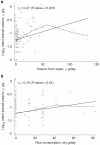Infant toenails as a biomarker of in utero arsenic exposure
- PMID: 24896769
- PMCID: PMC4141012
- DOI: 10.1038/jes.2014.38
Infant toenails as a biomarker of in utero arsenic exposure
Abstract
A growing body of evidence suggests that in utero and early-life exposure to arsenic may have detrimental effects on children, even at the low to moderate levels common in the United States and elsewhere. In a sample of 170 mother-infant pairs from New Hampshire, we determined infant exposure to in utero arsenic by evaluating infant toenails as a biomarker using inductively coupled plasma mass spectrometry. Infant toenail arsenic concentration correlated with maternal postpartum toenail concentrations (Spearman's correlation coefficient 0.34). In adjusted linear models, a doubling of maternal toenail arsenic concentration was associated with a 53.8% increase in infant toenail arsenic concentration as compared with 20.4% for a doubling of maternal urine arsenic concentration. In a structural equation model, a doubling of the latent variable integrating maternal toenail and urine arsenic concentrations was associated with a 67.5% increase in infant toenail arsenic concentration. A similar correlation between infant and maternal postpartum toenail concentrations was observed in a validation cohort of 130 mother-infant pairs from Rhode Island. In utero exposure to arsenic occurs through maternal water and dietary sources, and infant toenails appear to be a reliable biomarker for estimating arsenic exposure during the critical window of gestation.
Figures



Similar articles
-
Assessing the feasibility of using toenails as biomarkers for estimating inorganic arsenic exposure in Japanese adults.Environ Health Prev Med. 2024;29:59. doi: 10.1265/ehpm.24-00073. Environ Health Prev Med. 2024. PMID: 39496438 Free PMC article.
-
Toenail manganese as a potential biomarker for in utero and early childhood exposure studies.Sci Rep. 2018 Nov 19;8(1):17034. doi: 10.1038/s41598-018-35112-0. Sci Rep. 2018. PMID: 30451873 Free PMC article.
-
Maternal-infant biomarkers of prenatal exposure to arsenic and manganese.J Expo Sci Environ Epidemiol. 2015 Nov-Dec;25(6):639-48. doi: 10.1038/jes.2015.45. Epub 2015 Aug 26. J Expo Sci Environ Epidemiol. 2015. PMID: 26306926 Free PMC article.
-
Toenails as a biomarker of exposure to arsenic: A review.Environ Res. 2021 Apr;195:110286. doi: 10.1016/j.envres.2020.110286. Epub 2020 Oct 16. Environ Res. 2021. PMID: 33075355 Free PMC article.
-
Toenails as biomarker of exposure to essential trace metals: A review.Environ Res. 2019 Dec;179(Pt A):108787. doi: 10.1016/j.envres.2019.108787. Epub 2019 Oct 7. Environ Res. 2019. PMID: 31610392 Free PMC article. Review.
Cited by
-
Associations of Perinatal Metal and Metalloid Exposures with Early Child Behavioral Development Over Time in the New Hampshire Birth Cohort Study.Expo Health. 2024 Feb;16(1):135-148. doi: 10.1007/s12403-023-00543-2. Epub 2023 Mar 22. Expo Health. 2024. PMID: 38694196 Free PMC article.
-
Prenatal lead exposure and elevated blood pressure in children.Environ Int. 2018 Dec;121(Pt 2):1289-1296. doi: 10.1016/j.envint.2018.10.049. Epub 2018 Oct 31. Environ Int. 2018. PMID: 30389381 Free PMC article.
-
Parental metal exposures as potential risk factors for spina bifida in Bangladesh.Environ Int. 2021 Dec;157:106800. doi: 10.1016/j.envint.2021.106800. Epub 2021 Aug 3. Environ Int. 2021. PMID: 34358915 Free PMC article.
-
Urine and toenail cadmium levels in pregnant women: A reliability study.Environ Int. 2018 Sep;118:86-91. doi: 10.1016/j.envint.2018.05.030. Epub 2018 May 29. Environ Int. 2018. PMID: 29857281 Free PMC article.
-
Maternal arsenic exposure and gestational diabetes and glucose intolerance in the New Hampshire birth cohort study.Environ Health. 2016 Nov 8;15(1):106. doi: 10.1186/s12940-016-0194-0. Environ Health. 2016. PMID: 27825389 Free PMC article.
References
-
- Concha G, Vogler G, Lezcano D, Nermell B, Vahter M. Exposure to inorganic arsenic metabolites during early human development. Toxicol Sci. 1998;44:185–190. - PubMed
-
- Hamadani JD, Tofail F, Nermell B, Gardner R, Shiraji S, Bottai M, et al. Critical windows of exposure for arsenic-associated impairment of cognitive function in pre-school girls and boys: a population-based cohort study. Int J Epidemiol. 2011;40:1593–1604. - PubMed
Publication types
MeSH terms
Substances
Grants and funding
LinkOut - more resources
Full Text Sources
Other Literature Sources
Medical

